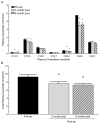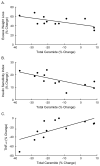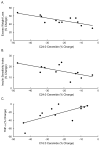Gastric bypass surgery reduces plasma ceramide subspecies and improves insulin sensitivity in severely obese patients
- PMID: 21546935
- PMCID: PMC3809956
- DOI: 10.1038/oby.2011.107
Gastric bypass surgery reduces plasma ceramide subspecies and improves insulin sensitivity in severely obese patients
Abstract
Bariatric surgery is associated with near immediate remission of type 2 diabetes and hyperlipidemia. The mechanisms underlying restoration of normal glucose tolerance postoperatively are poorly understood. Herein, we examined the effect of Roux-en-Y gastric bypass surgery (RYGB) on weight loss, insulin sensitivity, plasma ceramides, proinflammatory markers, and cardiovascular risk factors before and at 3 and 6 months after surgery. Thirteen patients (10 female; age 48.5 ± 2.7 years; BMI, 47.4 ± 1.5 kg/m(2)) were included in the study, all of whom had undergone laparoscopic RYGB surgery. Insulin sensitivity, inflammatory mediators and fasting lipid profiles were measured at baseline, 3 and 6 months postoperatively, using enzymatic analysis. Plasma ceramide subspecies (C14:0, C16:0, C18:0, C18:1, C20:0, C24:0, and C24:1) were quantified using electrospray ionization tandem mass spectrometry after separation with HPLC. At 3 months postsurgery, body weight was reduced by 25%, fasting total cholesterol, triglycerides, low-density lipoproteins, and free fatty acids were decreased, and insulin sensitivity was increased compared to presurgery values. These changes were all sustained at 6 months. In addition, total plasma ceramide levels decreased significantly postoperatively (9.3 ± 0.5 nmol/ml at baseline vs. 7.6 ± 0.4 at 3 months, and 7.3 ± 0.3 at 6 months, P < 0.05). At 6 months, the improvement in insulin sensitivity correlated with the change in total ceramide levels (r = -0.68, P = 0.02), and with plasma tumor necrosis factor-α (TNF-α) (r = -0.62, P = 0.04). We conclude that there is a potential role for ceramide lipids as mediators of the proinflammatory state and improved insulin sensitivity after gastric bypass surgery.
Conflict of interest statement
Figures



References
-
- Hill JO, Wyatt HR, Reed GW, Peters JC. Obesity and the environment: where do we go from here? Science. 2003 Feb 7;299(5608):853–5. - PubMed
-
- Tretjakovs P, Jurka A, Bormane I, Mackevics V, Mikelsone I, Balode L, et al. Relation of inflammatory chemokines to insulin resistance and hypoadiponectinemia in coronary artery disease patients. Eur J Intern Med. 2009 Nov;20(7):712–7. - PubMed
-
- Vazquez LA, Pazos F, Berrazueta JR, Fernandez-Escalante C, Garcia-Unzueta MT, Freijanes J, et al. Effects of changes in body weight and insulin resistance on inflammation and endothelial function in morbid obesity after bariatric surgery. J Clin Endocrinol Metab. 2005 Jan;90(1):316–22. - PubMed
-
- Summers SA. Ceramides in insulin resistance and lipotoxicity. Prog Lipid Res. 2006 Jan;45(1):42–72. - PubMed
Publication types
MeSH terms
Substances
Grants and funding
LinkOut - more resources
Full Text Sources
Medical
Research Materials

